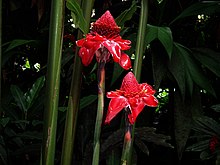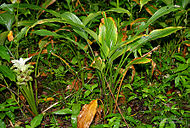

| Ginger family
| |
|---|---|

| |
| Red torch ginger (Etlingera elatior) | |
| Scientific classification | |
| Kingdom: | Plantae |
| Clade: | Tracheophytes |
| Clade: | Angiosperms |
| Clade: | Monocots |
| Clade: | Commelinids |
| Order: | Zingiberales |
| Family: | Zingiberaceae Martinov[2] |
| Type genus | |
| Zingiber Boehm. | |
| Genera[3] | |
|
57; see text | |
Zingiberaceae (/ˌzɪndʒɪbɪˈreɪsii/) or the ginger family is a familyofflowering plants made up of about 50 genera with a total of about 1600 known species[4] of aromatic perennial herbs with creeping horizontal or tuberous rhizomes distributed throughout tropical Africa, Asia, and the Americas. Many of the family's species are important ornamental, spice, or medicinal plants. Ornamental genera include the shell gingers (Alpinia), Siam or summer tulip (Curcuma alismatifolia), Globba, ginger lily (Hedychium), Kaempferia, torch-ginger Etlingera elatior, Renealmia, and ginger (Zingiber). Spices include ginger (Zingiber), galangal or Thai ginger (Alpinia galanga and others), melegueta pepper (Aframomum melegueta), myoga (Zingiber mioga), korarima (Aframomum corrorima), turmeric (Curcuma), and cardamom (Amomum, Elettaria).[5]
The earliest known fossils of the family belong to the Campanian age and are from the genera SpirematospermuminGermany,Tricostatocarpon and StriatornatainMexico, and MomordiocarponinIndia.[6][7] Spirematospermum chandlerae from the SantonianofNorth Carolina was previously classified in the Zingiberaceae, but more recent studies support it belonging to the Musaceae.[8][1]
Members of the family are small to large herbaceous plants with distichous leaves with basal sheaths that overlap to form a pseudostem. The plants are either self-supporting or epiphytic. Flowers are hermaphroditic, usually strongly zygomorphic, in determinate cymose inflorescences, and subtended by conspicuous, spirally arranged bracts. The perianth is composed of two whorls, a fused tubular calyx, and a tubular corolla with one lobe larger than the other two. Flowers typically have two of their stamenoids (sterile stamens) fused to form a petaloid lip, and have only one fertile stamen. The ovary is inferior and topped by two nectaries, the stigma is funnel-shaped.[citation needed]
Some genera yield essential oils used in the perfume industry (Alpinia, Hedychium).
57 genera are accepted.[3]
| Cladogram: Phylogeny of Zingiberales[9] | ||||||||||||||||||||||||||||||||||||
|
Phylogenetic tree of the family




The Zingiberaceae have a pantropical distribution in the tropics of Africa, Asia, and the Americas, with their greatest diversity in South Asia.
|
| |
|---|---|
| Banana-families |
|
| Zingiberineae (Ginger-families) |
|
| Zingiberaceae |
|
|---|---|